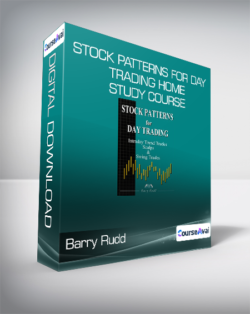This Stock Patterns For Day Trading describes the trading strategies used by a professional stock trader in his own trading. The ideas come both from friends who are successful traders as well as his own experience with SOES trading.Purchase Barry Rudd – Stock Patterns for Day Trading Home Study Course courses at here with PRICE $97 $35Barry Rudd – Stock Patterns for Day Trading Home Study CourseStock Patterns For Day Trading Home Study Course, Barry Rudd & Matt Rudd in 3 DVD + 10 hours of Level II quote screen tutorialsThis Stock Patterns For Day Trading describes the trading strategies used by a professional stock trader in his own trading. The ideas come both from friends who are successful traders as well as his own experience with SOES trading. The collection of trading patterns described represents one of the first full-fledged books of instruction on short term, swing and day trading in individual stocks. The author’s intraday trend trading approach and his scalping method are both described in detail. He uses the setups daily in his own trading. This course should prove valuable to the thousands of short term stock traders who seek to make their living from speculating on short term price swings. It is a toolbox for finding high probability trades for success as you trade the stock market. The technical ideas are primarily crafted around the personality of the NASDAQ market but may also be implemented in New York trades.VIDEO I (Introduction Module)Introduction to electronic direct access trading for stock day tradersOverview of Investing, Swing Trading, and Day TradingThe NYSE – structure of an “auction” marketNYSE order routing with SuperDOTRole of the SpecialistThe structure of the NASDAQ marketNASDAQ order routingUnderstanding ECNs (Electronic Communications Networks)Role of the Market MakersBasic terminologyUnderstanding the Level II quote windowComponents of the basic screen layout for your computerWhat are price bar charts?The daily bar chartThe 5 minute intraday bar chartUnderstanding how to use the stock tickerOrder entry and management windowsTracking the market indicesUsing candlestick chartsSummaryLevel II quote screen tutorialVIDEO IIIntroduction to methodology section of course (for tapes 2 – 6)Why use price bar charts to day trade?Scalping vs. intraday trend trading – overviewFind a trading style that fits your personalityKnow your exit price before you enter a tradeThe “Wiggle” – a detailed explanationHow to determine the current wiggle for each stock you tradeGenerating a computer screen layout for your tradingNavigating your tickers, charts, stock box and time and sales windowsInterpreting your tickersWhich indices to follow and whyUtilizing the “new high, new low” ticker5 minute bar chart patternsConsolidation breakout pattern – the dynamicsTiming your entry with the Level II & time and sales to get the best entry priceSpotting breakout patterns in advanceUsing another Level II window as a “launching pad” for trade entryVIDEO IIIWhat constitutes consolidation – the 3 main criteriaTying the bar chart price to the Level II quote screenInterpreting the time and sales “prints” in relation to Level II quote movement as a way to uncover buying or selling pressureThe Bull’s Horn pattern on the 5 minute chartListening to the market and reacting – don’t force a tradeIntraday wedge patternUsing the prior day’s intraday chart to enhance consolidation breakout tradesSupport and Resistance on micro and daily time frames – a visual indicator of potential halting points“Shotgun” pattern on the 5 minute bar chart with ensuing volume influx“L” pattern on the 5 minute bar chartMorning “Flashback” or headfake patternComputer screen examples of 5 minute bar chart patternsWide Range Day with Extreme Close – daily bar chart setupWide Range Day with slight gap outside, slight gap inside, the opening even with prior day’s close, and the big gap openTrading off micro support and resistance zones on wide range daysLarge price gap plays on the daily bar chartVIDEO IVMore on large gap openings on the daily bar chartComputer screen examples of wide range day setupsReversal setups on the daily bar chartIntraday (5 minute bar chart) dynamics of the Reversal setupWhere to enter and exit a reversal tradeScanning your daily charts to create a hit-list for the next trading sessionThe alternative entry to the intraday consolidation breakoutThe dangers of “randomly” picking tops and bottoms of price swings intradayVariation on the initial wiggle to better minimize losses on a losing tradeDaily congestion breakout plays – more stocks for the morning hit-listComputer screen examples of the Reversal setupProfit Targets – likely halting points to exit a trade:1. Daily price support and resistance2. Retracement of a Wide Range Day3. Reversal setup profit target4. 50 & 200 day simple moving averages5. The closing of a price gap on the daily chart6. Price spike on intraday chart7. Significant reversal in direction of market indices intradayFilters – filtering out the best potential day trades1. Too near a profit target2. Beware of trading a stock during daily congestion3. The cyclical nature of a stock’s “trader friendly” mode4. Significance of the typical daily range of a stockComputer screen examples of profit targets and filtersSummary – tying together all the trading analysisTrade checklist – 14 step flowchart process for evaluating, trading and managing high probability tradesGet Barry Rudd – Stock Patterns for Day Trading Home Study Course downloadVIDEO VFading (counter trend trading) techniques – not randomly picking tops and bottoms, but using specific criteria insteadProfit target reactions“Tagging”“Big Stack and a Rainbow”NASDAQ Level II quote screen – a fuller understandingUsing 4 key factors to gauge the risk of a stock1. The bid/ask spread2. Number of Market Makers and ECNs per price level3. Number of shares posted by each Market Maker and ECN4. The price difference between each “price level”How a Market Maker can act as the “ax” or “hammer” in a stockRelative Strength – daily and intraday – one of the most important factors in your trading decisionsMarket Indices – the trend vs. the immediate direction on the 5 minute chartMicro support and resistance on the indicesTypical market index behavior – morning move, mid-day, and afternoon moveVIDEO VIComputer screen index examples of relative strengthTime of day – finding the best times to trade (and the ones to avoid)What stocks to trade – how to choose your basket of stocksTrade analysis – trading as a businessManaging your trading vs. just managing a tradeMoney management – a three step approach to help minimize risk and lock in profitsIPOs and news tradesScalping profitably – beware the pitfallsThe art of tradingSome footage of “live trading”The “Stock Patterns for Day Trading Home Study Course” retail at $495.The training seminar cost $3,000. This Course were Sold out at the author’s website. Purchase Barry Rudd – Stock Patterns for Day Trading Home Study Course courses at here with PRICE $97 $35
 HeartMastery – Daily HeartStart Call Archives
₹5,810.00
HeartMastery – Daily HeartStart Call Archives
₹5,810.00
 Crypto Jack – CryptoJack’s Top 20 Coins For 2018
₹5,810.00
Crypto Jack – CryptoJack’s Top 20 Coins For 2018
₹5,810.00
Barry Rudd – Stock Patterns for Day Trading Home Study Course
₹5,810.00






